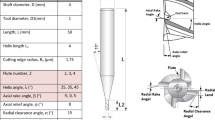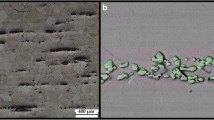Abstract
The use of self-moulding resins in industry makes it necessary to specify minimum values for the surface roughness parameters in order to avoid fluid leaks between the sealing planes. To meet this requirement, new tool classes, machining parameters, and methodologies are being used. Thus, this work applies a new methodology for plane milling, with the objective of increasing the tightness of the union with adhesive. The investigation was based on experimental planning techniques for the behaviour of the surface roughness in machining of AlSi9Cu3 alloy by frontal milling with refrigeration, carried out in a transmission union support, in high-speed cutting (HSC) machining centres. The evaluated parameters were the cutting speed (Vc) between 1250 m/min and 2250 m/min, and the feed per tooth (fz) between 0.050 mm/tooth and 0.100 mm/tooth. Two cutters with ten polycrystalline diamond (PCD) inserts were used to mill the sealing surface, with one of the cutters having eight cutting inserts and two scratching inserts. The cutoff considered was 2.5 mm and the statistical technique of design of experiment (DOE) was used to evaluate the experimental results. The optimum roughness values, achieved with the cutter with scratching inserts, were a Vc of 1250 m/min and fz of 0.05 mm/tooth.
Graphical Abstract















Similar content being viewed by others
Availability of data and material (data transparency)
Not applicable.
Code availability (software application or custom code)
Not applicable.
References
Choudhuri S, Shi J. (2017) Study of the industrial precision manufacturing and metallic alloys with respect to economic considerations. Munich Personal RePEc Archive, p. 1-30. https://mpra.ub.uni-muenchen.de/77481/1/MPRA_paper_77481.pdf
Verran GO, Mendes RPK, Rossi MA (2006) Influence of injection parameters on defects formation in die casting Al12Si1, 3Cu alloy: experimental results and numeric simulation. Journal of Materials Processing Technology 179:190–195. https://doi.org/10.1016/j.jmatprotec.2006.03.089
Basavakumar KG, Mukunda PG, Chakraborty M (2007) Influence of microstructure and turning inserts on machinability and surface characteristics of Al–7Si and Al–7Si–2.5Cu cast alloys. Materials Science and Engineering: A 465:85–94. https://doi.org/10.1016/j.msea.2007.03.078
Castro G, Almeida FA, Oliveira FJ, Fernandes AJS, Sacramento J, Silva RF. (2008) Dry machining of silicon-aluminium alloys with CVD diamond brazed and directly coated Si3N4 ceramic tools. Vacuum 82. https://doi.org/10.1016/j.vacuum.2008.03.042.
Bhowmick S, Banerji A, Alpas AT (2015) Tribological behavior of Al–6.5%, –12%, –18.5% Si alloys during machining using CVD diamond and DLC coated tools. Surface and Coatings Technology 284:353–364. https://doi.org/10.1016/j.surfcoat.2015.08.073
Su H, Liu P, Fu Y, Xu J (2012) Tool life and surface integrity in high-speed milling of titanium alloy TA15 with PCD/PCBN tools. Chinese Journal of Aeronautics 25:784–790. https://doi.org/10.1016/S1000-9361(11)60445-7
Brinksmeier E, Preuss W, Riemer O, Rentsch R (2017) Cutting forces, tool wear and surface finish in high speed diamond machining. Precision Engineering 49:293–304. https://doi.org/10.1016/j.precisioneng.2017.02.018
dos Santos GR, da Costa DD, Amorim FL, Torres RD (2007) Characterization of DLC thin film and evaluation of machining forces using coated inserts in turning of Al–Si alloys. Surface and Coatings Technology 202:1029–1033. https://doi.org/10.1016/j.surfcoat.2007.07.100
Silva WM, Jesus LM, Carneiro JR, Souza PS, Martins PS, Trava-Airoldi VJ (2015) Performance of carbide tools coated with DLC in the drilling of SAE 323 aluminum alloy. Surface and Coatings Technology 284:404–409. https://doi.org/10.1016/j.surfcoat.2015.09.061
Li G, Rahim MZ, Ding S, Sun S. (2016) Performance and wear analysis of polycrystalline diamond (PCD) tools manufactured with different methods in turning titanium alloy Ti-6Al-4V. International Journal of Advanced Manufacturing Technology 85. https://doi.org/10.1007/s00170-015-7949-6.
Tsai JT, Chang CC, Chen WP, Chou JH (2016) Optimal parameter design for IC wire bonding process by using fuzzy logic and Taguchi method. IEEE Access 4:3034–3045. https://doi.org/10.1109/ACCESS.2016.2581258
Montgomery DC (2017) Design and analysis of experiments. John Wiley & Sons, Arizona
Silva GC, Martins N, Santos IA, Vieira AL (2020) Analytical, numerical, and experimental investigation of the influence of lubrication on the drawing behavior of copper alloy. The International Journal of Advanced Manufacturing Technology 107:1773–1784. https://doi.org/10.1007/s00170-019-04895-5
Rodríguez-Loaiza P, Namur S, González-de la Parra M (2017) Application of design of experiments (DOE) to the development and validation of a swab sampling method for cleaning validation. Asian Journal of Chemistry and Phamaceutical. Sciences 2(1):16–21
Çolak O, Sunar T (2016) Cutting forces and 3D surface analysis of CFRP milling with PCD cutting tools. Procedia CIRP 45:75–78. https://doi.org/10.1016/j.procir.2016.03.091
Othman K, Ghani JA, Ruslan MS, Kassim MS (2018) Surface roughness of hypereutectic Al-Si A390 in high speed milling. Journal Tribology 16:42–50
Soares RB, de Jesus AMP, Neto RJL, Chirita B, Rosa PAR, Reis A. (2017) Comparison between cemented carbide and PCD tools on machinability of a high silicon aluminum alloy. Journal of Materials Engineering and Performance 26:4638–4657. https://doi.org/10.1007/s11665-017-2870-9.
Zuperl U, Cus F (2016) Surface roughness fuzzy inference system within the control simulation of end milling. Precision Engineering 43:530–543. https://doi.org/10.1016/j.precisioneng.2015.09.019
Bouzakis KD, Bouzakis E, Kombogiannis S, Makrimallakis S, Skordaris G, Michailidis N, et al. (2014) Effect of cutting edge preparation of coated tools on their performance in milling various materials. CIRP Journal of Manufacturing Science and Technology 7:264–273. https://doi.org/10.1016/j.cirpj.2014.05.003.
Acknowledgements
The authors are grateful to CNPQ, CAPES, FAPEMIG, Fiat Chrysler Automobiles (FCA), and Pontifical Catholic University of Minas Gerais (PUC-MG) for technical support.
Funding
This study was financed in part by the Coordenação de Aperfeiçoamento de Pessoal de Nível Superior—Brazil (CAPES)—Finance Code 001.
Author information
Authors and Affiliations
Contributions
Gilmar Cordeiro da Silva: conceptualization, project supervision, and writing; Querlem Martins Saraiva: conceptualization, experiments, writing; José Rubens Gonçalves Carneiro: conceptualization; Izabela Angela Santos: data analysis, writing; Anderson Silva José: experiments
Corresponding author
Ethics declarations
Ethics approval (include appropriate approvals or waivers)
Not applicable.
Consent to participate (include appropriate statements)
Not applicable.
Consent for publication (include appropriate statements)
Not applicable.
Conflict of interest
The authors declare no conflict of interest.
Additional information
Publisher’s note
Springer Nature remains neutral with regard to jurisdictional claims in published maps and institutional affiliations.
Rights and permissions
About this article
Cite this article
da Silva, G.C., Saraiva, Q.M., Carneiro, J.R.G. et al. New milling methodology for sealing planes in AlSi9Cu3(Fe) alloy machined with PCD tool. Int J Adv Manuf Technol 113, 3211–3223 (2021). https://doi.org/10.1007/s00170-021-06843-8
Received:
Accepted:
Published:
Issue Date:
DOI: https://doi.org/10.1007/s00170-021-06843-8




